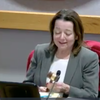Bernard Melewski — a master of the art of lobbying — shares stories of fighting to save the Adirondack Park
ALTAMONT — Bernard Melewski has spent most of his life working as an environmental lobbyist, and eight years writing a book about it.
“Inside the Green Lobby: The Fight to Save the Adirondack Park” has just been published by the State University of New York Press.
Melewski, who grew up in Halfmoon, has an abiding love for the Adirondacks and continues to be vitally interested in the park’s welfare.
“I was very fortunate to have an opportunity to have an outsized influence for one individual …,” he says in this week’s Enterprise podcast. “I often describe myself as a political scientist with a law degree and, as a political scientist, to be able to be at the front lines of influence and change over a long period of time, especially on things that are important to all of us, like the environment, I just couldn’t possibly imagine a better career outcome for me.”
One of his important contributions, detailed in the book, was to help end, or at least limit, the acid rain that was killing Adirondack wildlife.
As the full-time lobbyist for the Adirondack Council, Melewski orchestrated an Earth Day visit by President George W. Bush to Whiteface where the president promised he would put an end to acid rain, generated by factories elsewhere, that was harming the Adirondacks.
In his book, Melewski recalls a ride to the White House during which an aide of the president calls for advice. Melewski is unfamiliar with the term POTUS so the aide explains it means president of the United States.
“An aide is asking me to help tailor the public remarks of the president of the United States,” he writes. “Not bad for a blue collar boy from upstate New York.”
“I could not believe that I was traveling with our executive director for him — and I had actually promised him and was able to deliver that — …[to] meet with the president of the United States about our most important issue,” Melewski says. “I was momentarily overwhelmed and also naive.”
Ultimately, Bush’s clean-skies legislation stalled in Congress but Bush decided that, instead, the Environmental Protection Agency would pass regulations — the Clean Air Interstate Rule — to control the acid rain. So that section of Melewski’s book ends by stating Bush kept his promise.
“And, even as those regulations were fought tooth and nail by some parties all the way to the Supreme court, more than once, the trend or the outcome seemed inevitable to many …,” said Melewski. “So there was a significant shutdown of older boilers or them moving from coal to natural gas, etcetera.
“So there was a sudden drop in the pollutants,” Melewski said, making him “very happy that the lakes are coming back or we’re seeing trout in the lakes that saw no trout for many, many years.”
Asked about June’s Supreme Court ruling, in West Virginia v. EPA, that the EPA cannot put state-level caps on carbon emissions, Melewski said of the Inflation Reduction Act, passed in August, which is meant to drive global climate action, “In that comprehensive bill that passed with only 50 votes, buried in that was a statement that Congress recognized carbon dioxide as a pollutant.”
Melewski described this as a legislative response from Congress to the Supreme Court decision “that Congress had not given the EPA the authority to regulate carbon. Now it has.”
He added, “There was not a word spoken of this, that I could tell, in the press.”
Melewski went on, “It’ll be a glacial process. We’ll get challenged in the courts again … but at least they did address the fundamental problem the Supreme Court identified.
He stressed that it will take decades for the environment to right itself. “Spring shock,” caused by acidification every spring from pollutants streams carry over, hasn’t been eliminated.
Melewski started his job with the Adirondack Council in 1990 just before Governor Mario Cuomo’s commission was to release its much-anticipated report, “The Adirondacks in the 21st Century.”
The opening chapter of Melewski’s book starts with a colorful story — one of many throughout the book— of Melewski reading a bootlegged copy of the report as he rides a train to meet with the council.
As the train rattled on, Melewski made a list of all the people — developers, motel owners, snowmobilers, government officials, large landowners, the forest industry — who might hate the many recommendations.
“They are going to piss off a lot of people with this,” he concluded. And he was right.
The 6 million-acre Adirondack Park, covering a fifth of the state, is half private lands with over 130,000 residents and hundreds of small towns, villages, and hamlets.
In 1970, a commission report issued during Governor Nelson Rockefeller’s tenure led to setting up the Adirondack Park Agency, which had powers to supersede local zoning to contain development — and faced fierce resistance from residents in towns that had never had zoning.
The 1990 report, issued during Mario Cuomo’s administration, was expected by those on the commission that wrote it to bring about similar sweeping changes as a bond act was to provide money for the state to purchase lands from large family and lumber holdings that were breaking up.
But the bond issue failed in a state election and Melewski, who had envisioned himself in a job where he would oversee ribbon-cuttings instead found himself scrambling to negotiate deals that would save properties from development one parcel at a time.
In one negotiation, he played his last and best card by saying the Adirondack Council would tell the media that Governor George Pataki had become “the modern architect of the Adirondack Park.”
In another, he used careful research to undermine popular sentiment in favor of a plan by Marylou Whitney, the wealthy socialite, to sell the massive Long Lake estate she had inherited from her late husband with a scheme from her new husband John Hendrickson, to build a hotel and guest cottages.
Local politicians backed the plan, presuming it would bring tax revenue to the town. But the tide turned when the Adirondack Council released a report that showed the town would actually get more tax money if the land were sold to the state — state land pays full taxes in the Adirondack Park — than with the private vacation homes because of the way the plan was configured in which only the structures would be taxed not the forested land, which had tax breaks.
“Buy Whitney Park” showed up on bumpers with stickers printed by the Sierra Club and a local country radio station played, “Hello Marylou — Goodbye Park.”
In that maneuver, Melewski followed one of the tenets he outlines in his last chapter on the art of lobbying. As a graduate of Syracuse University College of Law, Melewski in 1978 became the Syracuse-based regional director of the New York Public Interest Research Group, receiving a federal grant to investigate property insurance redlining.
“This introduced me to one of the most cherished techniques in the advocacy world: thoroughly researching an issue that needs reform, publishing the results, and releasing the report (using a catch title) to the media,” Meleski writes in his book. “With the media coverage in hand, we would visit politicians or bureaucrats who could produce the change we were seeking and explain why reform was needed.”
While the stereotype many have of lobbyists riding corporate jets and wining and dining clients, Melewksi says, that may be true but does not apply to environmental lobbyists working for not-for-profits.
Rather, he outlines keys for success like: Know your issue, know the players, and “use your knowledge of the player to inform them, educate them, and to maintain a cordial exchange of views.”
Melewski believes that, because of the internet, now is the best of all times to be a citizen lobbyist. The internet allows citizens to easily research policy issues and to get copies of legislation from other states that can be emulated.
“You can frankly research the people you’re trying to influence to find out what their interests are, what their background has been …,” he said. “You can create a group of common people of common interest and keep them informed and be able to instantly get them to write a letter when it’s needed or come to a meeting or address other people.”
Melewski encourages people to move forward with issues they care about.
“The most important thing, the guiding light here, is the people you want to influence — you have to figure out why they should benefit … find out what motivates them … Know your audience and find a way that your goal is their goal. And that’s the ultimate art of lobbying.”



